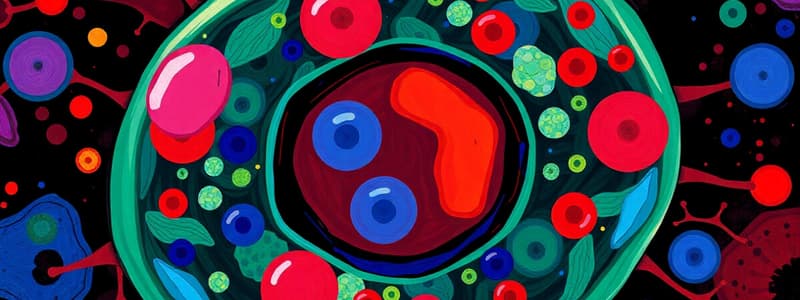Podcast
Questions and Answers
What is the primary function of the cell membrane?
What is the primary function of the cell membrane?
- Controlling the movement of substances in and out of the cell (correct)
- Producing energy for the cell
- Synthesizing proteins
- Storing genetic information
The Golgi bodies are responsible for producing proteins.
The Golgi bodies are responsible for producing proteins.
False (B)
What is the role of the lysosomes in a cell?
What is the role of the lysosomes in a cell?
Lysosomes contain enzymes that break down worn-out organelles and other cellular debris.
The ______ is often referred to as the 'powerhouse of the cell' because it is responsible for energy production.
The ______ is often referred to as the 'powerhouse of the cell' because it is responsible for energy production.
Match the following organelles with their primary functions:
Match the following organelles with their primary functions:
Which of the following is NOT a function of the cytoplasm?
Which of the following is NOT a function of the cytoplasm?
The smooth endoplasmic reticulum (SER) is involved in the synthesis of proteins.
The smooth endoplasmic reticulum (SER) is involved in the synthesis of proteins.
What is the function of the cell wall in plant cells?
What is the function of the cell wall in plant cells?
Flashcards
What is the nucleus of a cell?
What is the nucleus of a cell?
The control center of the cell, responsible for directing all cellular activities and containing genetic material.
What is the cell membrane?
What is the cell membrane?
A selectively permeable barrier that controls the movement of substances into and out of the cell.
What is the mitochondria?
What is the mitochondria?
The powerhouse of the cell, responsible for generating energy in the form of ATP.
What are ribosomes?
What are ribosomes?
Signup and view all the flashcards
What is the endoplasmic reticulum?
What is the endoplasmic reticulum?
Signup and view all the flashcards
What are Golgi bodies?
What are Golgi bodies?
Signup and view all the flashcards
What are vacuoles?
What are vacuoles?
Signup and view all the flashcards
What are lysosomes?
What are lysosomes?
Signup and view all the flashcards
Study Notes
Cell Parts and Functions
- Nucleus: The control center of the cell. Controls all cellular activities and is the sole site for chromosome reproduction.
Cell Membrane
- Cell Membrane: A structure that regulates the movement of substances into and out of the cell.
Cell Wall
- Cell Wall: An extra layer found in plant cells. A tough, supportive structure made of cellulose, protecting the cell from damage.
Cytoplasm
- Cytoplasm: Fills the cell and holds the organelles in place. Also aids in waste product breakdown.
Mitochondria
- Mitochondria: Often called the powerhouse of the cell. Responsible for energy production, vital for cellular growth and reproduction.
Ribosomes
- Ribosomes: Small, granular structures composed of RNA and proteins. Involved in protein production.
Smooth Endoplasmic Reticulum (SER)
- SER: A branching network (without ribosomes) involved in transporting large molecules within the cell. Sometimes referred to as the quality control unit of the cell.
Rough Endoplasmic Reticulum (RER)
- Rough ER: An organelle where many ribosomes are attached. Transporters for proteins produced by ribosomes.
Golgi Bodies
- Golgi Bodies: "Shippers of the cell." Package, modify, and transport materials within or outside the cell.
Vacuoles
- Vacuoles: "Refrigerator" of the cell. Membrane-bound organelles that store food, enzymes, and other cellular materials.
Vesicles
- Vesicles: "Jeepneys of the cell." Organelles that carry substances within or outside the cell. Necessary for transporting food into the cell.
Lysosomes
- Lysosomes: "Little stomachs" of the cell. Contain enzymes that break down worn-out organelles. Crucial for digestion and waste removal.
Centrosomes & Centrioles
- Centrosomes: Dense regions of cytoplasm that act as microtubule organizing centers.
- Centrioles: Barrel-shaped structures, perpendicular to each other, part of the centrosome, that aid in cell division.
Plastids
- Plastids: Involved in food production, particularly photosynthesis. Contain ribosomes and DNA.
- Chloroplasts: Found in green plants, contain chlorophyll.
- Chromoplasts: Found in yellow/orange plants in flowers/fruits/leaves.
- Leucoplasts: Colorless plastids that store carbohydrates, proteins, and fats.
Cytoskeleton
- Cytoskeleton: A network of thin, fibrous elements, providing structural support, and involved in cell movement, similar to the bones and muscles of the cell.
Studying That Suits You
Use AI to generate personalized quizzes and flashcards to suit your learning preferences.




